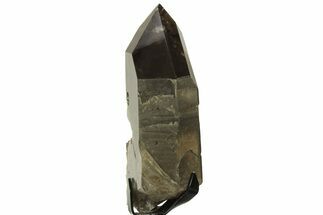This Specimen has been sold.
2.6" Spessartine Garnets & Smoky Quartz on Feldspar - China
Here is a beautiful, 2.6" long specimen that contains spessartine garnets and smoky quartz that formed from a bed of feldspar, collected from Fujiang, China. Many of the crystals are in excellent condition, unfortunately some of the larger quartz crystals have broken free from this specimen.
Feldspars are a group of rock-forming tectosilicate minerals. They are the most common minerals on Earth, making up nearly 60% of the crust.
About Quartz
Quartz is the name given to silicon dioxide (SiO2) and is the second most abundant mineral in the Earth's crust. Quartz crystals generally grow in silica-rich environments--usually igneous rocks or hydrothermal environments like geothermal waters--at temperatures between 100°C and 450°C, and usually under very high pressure. In either case, crystals will precipitate as temperatures cool, just as ice gradually forms when water freezes. Quartz veins are formed when open fissures are filled with hot water during the closing stages of mountain formation: these veins can be hundreds of millions of years old.
Quartz is the name given to silicon dioxide (SiO2) and is the second most abundant mineral in the Earth's crust. Quartz crystals generally grow in silica-rich environments--usually igneous rocks or hydrothermal environments like geothermal waters--at temperatures between 100°C and 450°C, and usually under very high pressure. In either case, crystals will precipitate as temperatures cool, just as ice gradually forms when water freezes. Quartz veins are formed when open fissures are filled with hot water during the closing stages of mountain formation: these veins can be hundreds of millions of years old.
Smoky quartz is a grey-brown to black variety of quartz. This common name is derived from the appearance of smoke within the quartz crystal. Depending on the location and the chemicals present during formation, smoky quartz can appear opaque black, but it is typically translucent to some extent. It is believed that the quartz gains this color from a combination of natural irradiation and aluminum impurities.
Garnets are nesosilicates with the general formula X3Y2(SiO4)3. Garnets come in many species, including pyrope, almandine (the most common species), spessartine, uvarovite, andradite and grossular, varieties of which are hessonite, cinnamon-stone, and tsavorite. Garnets are found in a wide variety of colors including red, orange, yellow, green, purple, brown, blue, black, pink, and colorless, though reddish shades are the most common.
SPECIES
Spessartine Garnet, Quartz var. Smoky & Feldspar
LOCATION
Tongbei, Yunxiao County, Fujiang, China
SIZE
2.6" long, 2.1" wide
CATEGORY
SUB CATEGORY
ITEM
#95187
 Reviews
Reviews














